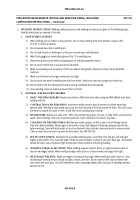TM-9-2350-261-34 - Page 118 of 785
TM 9-2350-261-34
PREVENTIVE MAINTENANCE CHECKS AND SERVICES (PMCS), INCLUDING
LUBRICATION INSTRUCTIONS — Continued
0014 00
i.
OIL PASSAGES.
1)
Make sure all oil passages are not clogged.
2)
Clean oil passages and break up any sludge or gum deposits.
WARNING
Air pressure in excess of 30 psi (207 kPa) can injure personnel. Do not direct pressurized air
at yourself or others. Always wear goggles.
3)
Flush oil passages with solvent, cleaning compound. Dry parts with compressed air.
j.
OIL SEALS, ELECTRICAL CABLES, AND FLEXIBLE HOSES.
Clean seals, cables, and flexible hoses
with detergent and water. Dry parts with wiping rag.
WARNING
Air pressure in excess of 30 psi (207 kPa) can injure personnel. Do not direct pressurized air
at yourself or others. Always wear goggles.
k.
INSERTS.
Blow out insert holes with compressed air.
l.
GASKETS.
If gasket is being removed, scrape old gasket material and sealant off mating surface. Clean mating
surface with solvent, cleaning compound. Dry with wiping rag.
9.
INSPECTION.
All parts must be inspected with care. Replace parts if damage or wear exceeds allowable limits.
a.
GENERAL.
Procedures for inspection will be the same for most parts. General inspection procedures are given in
the following steps. Special inspection procedures are covered in the task as needed.
b.
CASTINGS.
1)
Use magnetic particle inspection equipment to check ferrous castings for cracks. Use a magnifying glass and
strong light to check nonmetal castings for cracks. Check areas next to studs, threaded inserts, sharp corners,
and fillets.
2)
Inspect all castings and forgings for breaks, cracks, and wear or scoring that would impair function.
3)
Inspect machined surfaces for nicks, burrs, and raised metal. Mark damaged areas for repair.
4)
Use straightedge to check all mounting flanges on housings and supports for bends. Inspect mating flanges for
stains which would indicate oil leakage.
5)
Inspect all threaded parts for damaged or stripped threads.
c.
ROLLER AND BALL BEARINGS.
Inspect bearing races for wear and color changes due to heat. See TM 9-214
for inspection procedures for ball bearings.
001400-5
Back to Top




















